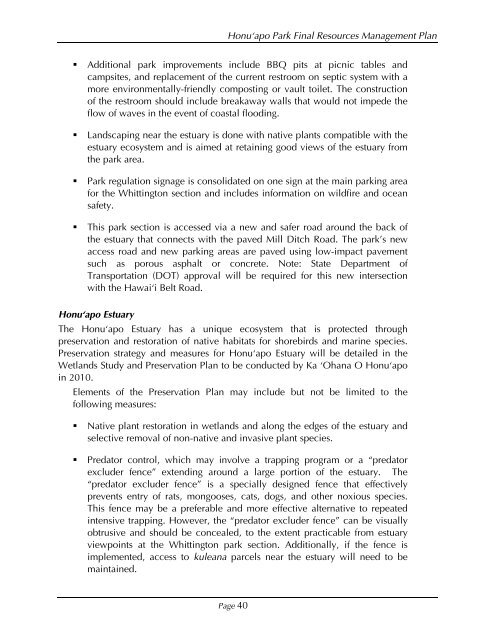Honu'apo Park Resource Management Plan
Honu'apo Park Resource Management Plan
Honu'apo Park Resource Management Plan
Create successful ePaper yourself
Turn your PDF publications into a flip-book with our unique Google optimized e-Paper software.
Honuÿapo <strong>Park</strong> Final <strong>Resource</strong>s <strong>Management</strong> <strong>Plan</strong><br />
� Additional park improvements include BBQ pits at picnic tables and<br />
campsites, and replacement of the current restroom on septic system with a<br />
more environmentally-friendly composting or vault toilet. The construction<br />
of the restroom should include breakaway walls that would not impede the<br />
flow of waves in the event of coastal flooding.<br />
� Landscaping near the estuary is done with native plants compatible with the<br />
estuary ecosystem and is aimed at retaining good views of the estuary from<br />
the park area.<br />
� <strong>Park</strong> regulation signage is consolidated on one sign at the main parking area<br />
for the Whittington section and includes information on wildfire and ocean<br />
safety.<br />
� This park section is accessed via a new and safer road around the back of<br />
the estuary that connects with the paved Mill Ditch Road. The park’s new<br />
access road and new parking areas are paved using low-impact pavement<br />
such as porous asphalt or concrete. Note: State Department of<br />
Transportation (DOT) approval will be required for this new intersection<br />
with the Hawaiÿi Belt Road.<br />
Honuÿapo Estuary<br />
The Honuÿapo Estuary has a unique ecosystem that is protected through<br />
preservation and restoration of native habitats for shorebirds and marine species.<br />
Preservation strategy and measures for Honuÿapo Estuary will be detailed in the<br />
Wetlands Study and Preservation <strong>Plan</strong> to be conducted by Ka ÿOhana O Honuÿapo<br />
in 2010.<br />
Elements of the Preservation <strong>Plan</strong> may include but not be limited to the<br />
following measures:<br />
� Native plant restoration in wetlands and along the edges of the estuary and<br />
selective removal of non-native and invasive plant species.<br />
� Predator control, which may involve a trapping program or a “predator<br />
excluder fence” extending around a large portion of the estuary. The<br />
“predator excluder fence” is a specially designed fence that effectively<br />
prevents entry of rats, mongooses, cats, dogs, and other noxious species.<br />
This fence may be a preferable and more effective alternative to repeated<br />
intensive trapping. However, the “predator excluder fence” can be visually<br />
obtrusive and should be concealed, to the extent practicable from estuary<br />
viewpoints at the Whittington park section. Additionally, if the fence is<br />
implemented, access to kuleana parcels near the estuary will need to be<br />
maintained.<br />
Page 40


